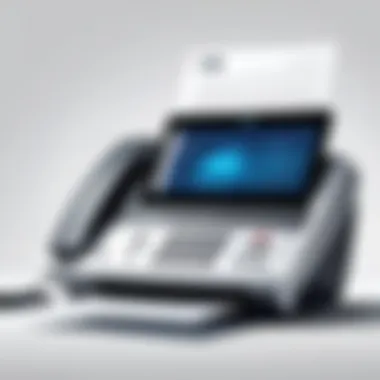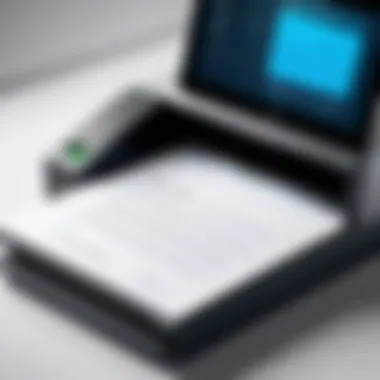Exploring Fax Over Network Technologies: A Comprehensive Guide


Intro
As organizations strive for efficiency and rely on technology to streamline operations, understanding fax over network technologies becomes vital. Traditional fax machines, while still in use, are increasingly being replaced by digital solutions. The shift to fax over Internet Protocol, or FoIP, represents a significant evolution in how information is transmitted securely and reliably. This article provides an in-depth look at the mechanisms, advantages, and challenges that come with this transition, making it an essential read for IT professionals and tech enthusiasts alike.
Hardware Overview
Specifications
The hardware requirements for implementing fax over network technology can vary based on the specific solution in use. At the core, devices must support VoIP standards. Common specifications include:
- Processor Speed: A fast processor is crucial for handling multiple fax transmissions simultaneously.
- Memory: Adequate RAM is necessary to process data effectively.
- Network Interface: A reliable Ethernet or Wi-Fi connection ensures consistent data transmission.
- Compatibility: Make sure that the fax server supports the desired protocols such as T.38.
Performance Metrics
Understanding the performance of fax over internet solutions is essential for evaluating their efficiency. Key metrics include:
- Transmission Speed: FoIP can achieve faster transmission rates compared to traditional faxing, with speeds reaching up to 33.6 Kbps under optimized conditions.
- Error Rates: An effective FoIP system should have minimal error rates, ideally lower than 1%.
- Mean Time to Repair (MTTR): This metric indicates how quickly a system can recover from a failure. A lower MTTR suggests a more reliable system.
Software Analysis
Features and Functionality
Modern FoIP systems provide a range of features that enhance user experience and operational efficiency. Important functionalities to consider include:
- Integration with Email: Users can send and receive faxes directly through email, simplifying the process.
- Document Management: Many solutions offer document storage options, allowing for easier retrieval and management.
- Security Protocols: Enhanced encryption methods help safeguard sensitive data during transmission.
- Multi-User Capability: Supports multiple users accessing the system simultaneously, which is essential for larger organizations.
User Interface and Experience
User experience in software is crucial for ensuring user engagement and effectiveness. A clean and intuitive interface reduces the learning curve for new users. Key elements include:
- Dashboard Layout: A well-organized dashboard provides users quick access to essential functions.
- Customization Options: Allowing users to customize settings can enhance their overall experience.
- Mobile Access: Many modern systems also offer mobile applications or responsive interfaces for easy access on various devices.
"The move to FoIP represents a blending of traditional faxing with modern internet capabilities, offering new opportunities for businesses to streamline communication."
Prelims to Fax Over Network
Understanding Fax Over Network technologies is important in today's digital age. This shift from traditional fax methods to modern techniques is reshaping communication protocols in various sectors. It allows organizations to transmit documents efficiently without relying on outdated fax machines, saving both time and resources. Thus, an exploration into these technologies is beneficial for IT professionals and tech enthusiasts alike.
Defining Fax Over Network
Fax Over Network refers to the method of sending and receiving fax communications over Internet Protocol (IP) networks instead of traditional telephone lines. By converting documents into digital data, these systems utilize existing network infrastructures to transmit faxes. This method provides greater flexibility and efficiency. Organizations can integrate FoIP within their digital workflows, offering a seamless experience. Furthermore, users can access their fax services from any device connected to the internet, which increases productivity in the workplace.
Historical Context
The traditional fax machine surged in popularity during the 1980s and 1990s as a trusted method for sharing documents quickly. However, reliance on physical machines comes with limitations like the need for dedicated lines and bulky hardware. As technology advanced, especially with the advent of the internet, the need for efficient and modern alternatives grew.
In the late 1990s, the introduction of Fax Over IP began to emerge. Companies sought to reduce costs associated with paper, ink, and maintenance of machines. The transition to FoIP coincided with the rise of digital communication methods, paving the way for a more integrated approach. By understanding the historical progression, one can appreciate the relevance and efficacy of faxing via network technologies in the present day.
Mechanics of Fax Over Internet Protocol
The Mechanics of Fax Over Internet Protocol (FoIP) is central to understanding how traditional fax functionalities transition into the modern digital realm. This section explores the essential components that form the foundation of FoIP, as well as the operational principles that ensure reliable fax communication over internet-based networks. This knowledge is critical for IT professionals and tech enthusiasts who are navigating the evolving landscape of business communication solutions.
Fundamental Components
Understanding the fundamental components of Fax Over Internet Protocol involves recognizing the various technologies that facilitate the process. These include:
- Fax Server: A crucial component that acts as a bridge between traditional fax machines and the internet. It manages incoming and outgoing fax transmissions, ensuring they reach their intended destinations efficiently.
- VoIP Gateway: A device that converts analog signals from a traditional fax machine into digital signals that can be transmitted over the internet. This gateway also performs the reverse conversion for incoming faxes.
- Transmission Protocols: Protocols such as T.38 play a significant role in transmitting fax data. They ensure the integrity and quality of the fax by providing error correction and supporting various transmission rates.
- Network Infrastructure: A reliable network is crucial for successful FoIP. This includes routers, switches, and internet bandwidth, all of which affect transmission speed and quality.
- Email Integration: Many FoIP systems can send and receive faxes directly through email, adding another layer of functionality and convenience in business environments.


These components together create a framework that allows businesses to leverage faxing in a cost-effective and efficient manner, replacing outdated machines without losing essential functionalities.
How FoIP Works
Examining how FoIP works provides insights into its operational mechanics. The process begins with a user initiating a fax from either a traditional fax machine or a computer. Here’s a breakdown of the typical flow:
- Initiating a Fax: The fax is sent from the user’s device. If using a traditional machine, it connects to the VoIP gateway.
- Conversion of Signal: The VoIP gateway converts the analog signal into digital format for internet transmission. This is essential as it allows the fax to traverse the digital landscape.
- Data Transmission: Using the established protocols, the digital data is sent over the internet to the recipient’s network. This step must be timely and efficient to avoid data loss and ensure the integrity of the fax.
- Reception: Upon reaching the destination, the fax data is converted back into a format that the receiving fax machine or server can understand.
- Delivery: Finally, the fax is printed out or saved in the receiving system, completing the transmission process.
The success of FoIP hinges on the quality of the network connection and the efficiency of the components working together. High reliability and immediate accessibility for the end-user are key advantages that continue driving the adoption of this technology.
"Fax Over Internet Protocol modernizes faxing by integrating it with existing network infrastructures, preserving business communication integrity while reducing costs."
As digital solutions become more prevalent, grasping the mechanics of Fax Over Internet Protocol becomes indispensable for businesses aiming to streamline operations and improve communication efficiency.
Protocols and Standards
The realm of fax over network technologies hinges on the adherence to standardized protocols. For IT professionals, understanding these protocols is essential for ensuring efficient and reliable communication through faxing systems. Protocols facilitate the transfer of data between devices and networks, thus establishing a common framework ensuring compatibility and interoperability. This is particularly vital in a landscape where organizations might intermingle newer digital processes with legacy systems.
Standardization helps to mitigate issues that arise from differences in hardware and software from varied manufacturers. Importantly, protocols provide a blueprint for effective communication, enabling seamless fax transactions while ensuring that quality and security are maintained. With the rapid evolution of technology, the importance of rigorously defined protocols cannot be understated.
T. Protocol
T.38 is a pivotal protocol designed specifically for faxing over Internet Protocol (IP) networks. It addresses the challenges posed by the transmission of fax data over networks that may not guarantee real-time, reliable delivery. T.38 operates by converting fax signals into digital data packets that can be sent over the internet. This approach allows for effective error correction and control mechanisms.
The protocol's significance lies in its ability to handle the unique requirements of fax transmissions, which often differ from standard data transfers. With T.38, the risk of data loss is minimized. Organizations utilizing T.38 can maintain the fidelity of their fax communications, which is crucial for legal documents, contracts, and sensitive information.
Furthermore, T.38 supports various network conditions, making it adaptable to different environments. This flexibility ensures that even in less-than-ideal network circumstances, fax jobs can be completed successfully. It’s an integral component for any modern faxing solution that seeks to harness the advantages of digital technology while retaining the robustness of traditional faxing standards.
SIP-Based Solutions
Session Initiation Protocol (SIP) serves as another critical component in the ecosystem of fax over networks. SIP is a signaling protocol used for initiating, maintaining, and terminating real-time sessions that involve video, voice, and messaging applications. In the context of fax, SIP facilitates the establishment of sessions that are vital for sending documents via an IP network.
Applications leveraging SIP can integrate fax capabilities as part of broader communication solutions. This creates opportunities for businesses to streamline operations and improve collaboration across different teams. SIP-based solutions enable advanced features, such as the ability to coalesce voice and fax transmissions over a single infrastructure, thus reducing costs and complexity.
Moreover, SIP inherently supports features like authentication, which enhances security during fax transmissions. As organizations increasingly recognize the importance of unified communications, SIP-based fax solutions will likely gain prominence, driving further evolution in the realm of fax over digital networks.
"Protocols and standards not only simplify interoperability between devices but are critical in ensuring the reliability and security of fax communications in complex environments."
Advantages of Fax Over Network
Fax over network technologies, particularly FoIP, offers various benefits that have made it a compelling choice for businesses. The transition from traditional faxing to digital systems is not only driven by the need for efficiency but also by several advantages that align with contemporary operational requirements.
Cost Efficiency
One of the standout benefits of fax over network solutions is their cost efficiency. Traditional fax machines incur expenses related to paper, toner, and telephone lines. In contrast, FoIP reduces these costs significantly. With faxing being integrated into existing internet connections, organizations minimize additional telecommunications expenses. The elimination of physical resources also lowers environmental impact, aligning with sustainability goals.
In many cases, digital faxing solutions offer pay-per-use models, allowing businesses to adapt their spending as needed. This flexibility is particularly valuable for minimizing costs associated with infrequent fax usage. Companies can also leverage online services like eFax that charge based on actual use instead of maintaining costly machines.
"Organizations can save up to 50% on fax-related expenses when switching to digital solutions, demonstrating significant cost advantage."
Improved Security
Another important aspect of fax over network technologies is improved security. Traditional fax machines can pose risks such as the potential for unauthorized access or the loss of sensitive documents. In contrast, FoIP often employs advanced encryption protocols to enhance data protection. This reduces the chances of interception while the documents are in transit.
Moreover, digital faxing allows for features like authentication, ensuring that only authorized personnel can send or receive faxes. Audit trails are another layer of security that track who accessed sensitive information, particularly significant for compliance with regulations such as HIPAA or GDPR. The security of transmitted data becomes a priority, making organizations feel more safeguarded when communicating confidential information through fax.
Integration with Digital Workflows


The integration of fax over network technologies with existing digital workflows is another critical benefit that organizations seek. FoIP solutions can seamlessly connect with email systems, document management platforms, and customer relationship management tools. This integration helps streamline communication processes, reducing duplication and improving accessibility.
For instance, employees can send files directly from their email client to a fax machine or an online fax system with just a few clicks. This functionality not only saves time but also plays a role in enhancing productivity. Organizations can also automate tasks associated with faxing, such as filing incoming documents electronically. This enhances overall workflow efficiency, as information is progressively digitized rather than stored on paper.
The advantages of fax over network technologies present a clear case for their adoption, particularly for businesses seeking to improve efficiency, security, and workflow integration. Understanding these benefits can help organizations make informed decisions about transitioning from traditional faxing to FoIP.
Challenges and Limitations
Understanding the challenges and limitations associated with fax over network systems is critical for IT professionals and organizations leveraging these technologies. While fax over Internet Protocol (FoIP) offers numerous benefits, it also poses specific hurdles that can impact transmission quality, network reliability, and compliance with regulations. Addressing these challenges is vital to enhance overall efficiency and effectiveness in communications.
Quality of Transmission
One of the primary concerns in fax over network is the quality of transmission. Traditional analog fax machines operate over dedicated phone lines, providing consistent quality. However, FoIP relies on internet connections, which may introduce variability in the quality of the fax sent or received. Factors impacting this quality include bandwidth availability, latency, and data packet loss.
Symptoms of poor transmission quality can manifest as unreadable documents or incomplete faxes. To mitigate such issues, organizations should prioritize high-quality, stable internet connections. Additionally, utilizing protocols like T.38 can aid in maintaining the integrity of fax transmissions. Regular network evaluations can help identify potential areas for improvement to enhance quality.
Dependence on Network Reliability
The dependence on network reliability can greatly impact fax communications. Unlike the traditional fax setup, where a fax machine functions independently of internet connectivity, FoIP relies entirely on the stability and availability of the company's network. Sudden outages or spikes in traffic can lead to failed transmissions or delays.
Ensuring a reliable network means implementing measures such as load balancing, using high-quality routers, and having backup connections available. Additionally, organizations must train IT staff to quickly diagnose and resolve issues to minimize downtime and prevent disruptions in fax operations.
Compliance and Regulatory Issues
Operational compliance is another significant factor in the challenges associated with fax over network. Compliance regulations, such as HIPAA in healthcare, require the secure transmission of sensitive documents. Failing to adhere to these regulations can lead to grave legal and financial consequences.
Organizations must understand the importance of implementing robust security measures in their FoIP systems. This often includes using encryption methods and adhering to strict access control policies to safeguard sensitive data during transmission. Regular audits can also help ensure compliance with relevant regulations, and strategy for maintaining adherence should be continuously evaluated as technologies and regulations evolve.
"The shift from traditional faxing to network-based solutions introduces complexities that demand rigorous attention to quality, reliability, and compliance."
By recognizing these challenges, organizations can better prepare to address them, ultimately ensuring more reliable communications and contributing to a seamless digital workflow.
Security Considerations
In an era where digital communication is pervasive, security considerations in fax over network technologies are paramount. Fax over Internet Protocol (FoIP) delivers significant advantages, but it also brings potential vulnerabilities. IT professionals must recognize the importance of safeguarding sensitive data transmitted via fax. Understanding the underlying security mechanisms is essential for maintaining confidentiality and trust in communication processes.
Encryption Standards
Encryption stands as a fundamental line of defense against unauthorized access. In the context of FoIP, various encryption methods ensure that data is not intercepted during transmission. The use of Transport Layer Security (TLS) is prevalent in establishing a secure connection. TLS encrypts data packets, protecting them from eavesdropping. Additionally, adopting Advanced Encryption Standard (AES) enhances the security of the content being transmitted.
Organizations should implement encryption protocols rigorously. Effective measures include:
- Establishing policies that mandate encryption for all sensitive faxes.
- Regularly updating encryption software to mitigate vulnerabilities.
- Training staff on the importance of safeguarding data through encrypted channels.
"Encryption protects sensitive information from being accessed by unintended parties."
The choice of encryption standard can significantly impact the overall security of FoIP systems. Adopting robust standards ensures that communications remain confidential, reinforcing the reliability of electronic fax systems in business environments.
Data Breach Risks
Despite the robust security measures in place, FoIP systems are not immune to data breaches. These risks can emerge from multiple sources, including weak passwords, outdated software, and unauthorized access. When breaching occurs, the ramifications can be severe. Sensitive information may be exposed, leading to financial losses and damage to organizational reputation.
To mitigate potential data breach risks, organizations should consider the following strategies:
- Conduct regular security assessments to identify vulnerabilities.
- Implement strong password policies to control access to FoIP systems.
- Ensure that all software and hardware are updated promptly to protect against known threats.
- Educate users on recognizing phishing attacks and other social engineering tactics that may compromise data security.
Assessing the specific risks inherent in fax over network technology is crucial. By maintaining awareness of these threats and implementing preventive strategies, organizations can navigate the landscape of digital faxing with greater confidence.


Integration with Other Technologies
In the rapidly evolving landscape of communication technologies, the integration of fax over Internet Protocol (FoIP) with various other systems is imperative. This synergy not only enhances the functionality of fax services but also increases operational efficiency for organizations. The intersection of FoIP with other digital infrastructures facilitates smoother workflows and improves accessibility to important documents. By connecting faxing solutions with tools that businesses already use, organizations can streamline processes and save valuable resources.
Connecting FoIP with Email Systems
Integrating FoIP with email systems presents numerous advantages. This approach allows businesses to send and receive faxes directly from their email applications. The resulting convenience simplifies document management and communication, enabling users to operate within a familiar interface. Numerous businesses have found that
- Reduced time is needed to send or receive faxes
- Less training is required for employees willing to utilize digital tools
- Enhanced tracking of sent and received documents becomes possible without additional software.
Most importantly, connecting FoIP with an email system ensures that faxes are stored digitally, thereby facilitating easy retrieval and organization. Employees no longer have to sift through piles of paper or worry about misplacing important documents.
Utilizing Cloud Solutions
The adoption of cloud technologies has transformed how organizations manage their communications, including faxing. FoIP systems can seamlessly integrate with cloud solutions, allowing businesses to send and receive faxes over the internet without the need for dedicated hardware. This approach provides scalability and flexibility, crucial for organizations of varying sizes. Some benefits that come with utilizing cloud-based FoIP solutions are:
- Accessibility from anywhere—users can access their fax services remotely, fostering continuity of operations.
- Cost savings, as companies can reduce hardware investments and ongoing maintenance costs.
- Automatic updates to software features, ensuring users always work with the latest enhancements.
Organizations need to select a cloud provider carefully. Security measures, compliance with regulations, and the reliability of service are paramount considerations.
"Integrating fax over network technologies with existing systems allows businesses to enhance their communication capabilities while reducing costs and increasing productivity."
The integration of FoIP with other technologies represents a critical evolution in faxing methods. It gives companies the tools they need to adapt to modern communication practices while maintaining the functionality required for critical operations.
Future Trends in Fax Over Network
Understanding future trends in Fax Over Network (FoIP) is essential for anyone involved in communication technologies. As businesses transition to digital solutions, grasping how these trends will shape operational efficiency becomes a necessity. This section underscores key elements to keep in mind regarding the evolution of faxing technologies, their benefits, and the important considerations surrounding these advancements.
Evolution of FoIP Technology
The evolution of FoIP technology is characterized by remarkable advancements. Traditional fax machines operated solely on analog lines, which often led to inefficiencies. With the shift towards digitalization, technologies such as the T.38 protocol emerged, allowing for more reliable transmission over Internet Protocol networks. This protocol provides a means to overcome quality issues typically experienced with conventional fax machines.
Moreover, improvements in compression methods have made it easier to transmit large volumes of documents without sacrificing clarity or detail. Enhanced interoperability between different systems stands as a pivotal development. Now, organizations can send faxes from various devices, including computers and smartphones, which fosters greater flexibility and convenience.
The evolution does not stop here. Future technologies might include integration with artificial intelligence. For instance, AI can automate document routing, ensure compliance with regulations, and enhance document management systems. Therefore, understanding these evolving technologies can enable businesses to better prepare for the complexities of modern communication systems.
Increasing Adoption in Businesses
The increasing adoption of fax over network technologies among businesses indicates a significant trend. Many companies, especially those in healthcare, legal, and finance sectors, rely heavily on faxing to manage sensitive information. The move towards foip allows for streamlined processes, resulting in improved productivity.
Businesses are increasingly aware of the security measures associated with FoIP. It incorporates encryption standards that safeguard data during transmission, making it a preferred option compared to traditional faxing. Organizations are eager to adopt solutions that meet regulatory requirements while providing a secure environment for sensitive documents.
In addition, the rise of remote work has propelled the need for flexible communication methods. FoIP offers capabilities like cloud integration, allowing employees to send and receive faxes from anywhere, anytime. This has not only enhanced operational efficiency but also promoted a more agile work environment.
As the market adapts, the demand for FoIP solutions is expected to grow. Companies that invest in these technologies will likely see long-term benefits, from cost savings to enhanced collaboration across departments.
The ongoing evolution of FoIP and its increasing adoption will likely transform how organizations approach document management and communication. Therefore, staying informed about these trends is not just beneficial but necessary for thriving in today’s digital landscape.
Ending
The conclusion of this article serves as a critical reflection on the intricacies of fax over network technologies. It draws together the various threads discussed throughout the piece, ultimately highlighting the importance of understanding both the benefits and the challenges associated with these systems. In an era characterized by rapid technological advancements, grasping the realities of fax over Internet Protocol (FoIP) becomes ever more essential for IT professionals and businesses alike.
Summary of Key Points
Throughout the article, we explored several key points about fax over network technologies. These include:
- The fundamental mechanics of FoIP, elucidating how these technologies operate.
- The variety of protocols relevant to this field, particularly T.38 and SIP, which underlie the functionality of FoIP solutions.
- Advantages such as cost efficiency, improved security measures, and seamless integration with contemporary digital workflows.
- Challenges faced, including quality transmission concerns and the necessity of a reliable network infrastructure.
- Security considerations like encryption standards and risks associated with data breaches.
- The increasing importance of integrating fax with emerging technologies, including email systems and cloud solutions.
- A forward-looking perspective on upcoming trends and the continuing evolution of fax technologies into broader business applications.
These points underscore a comprehensive grasp of how faxing has transformed in the digital age.
The Importance of Staying Informed
"In the realm of technology, remaining static is not an option. Adaptation is key to success."
Ultimately, as communication technology continues to evolve, professionals who prioritize staying informed will be better positioned to leverage advancements and enhance their operational efficiencies.



